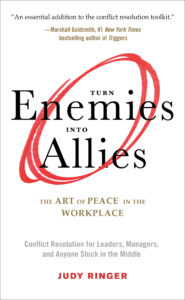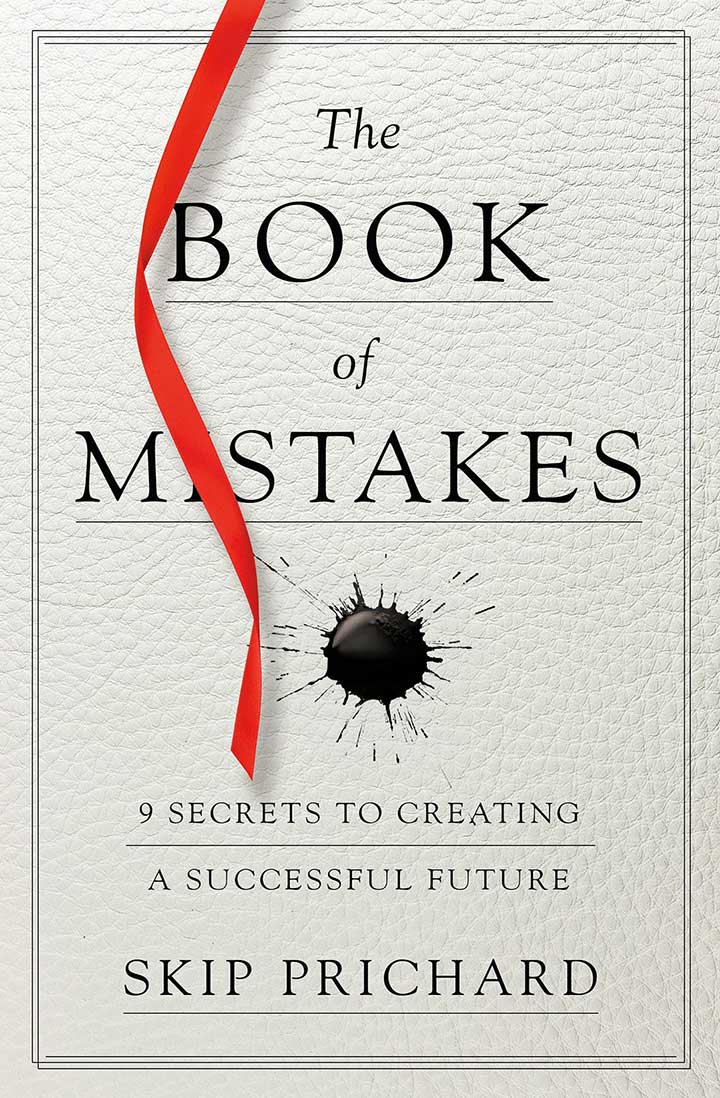Dealing with Conflict
Are you uncomfortable with conflict?
What do you do when you see two coworkers who fight or just don’t get along?
It’s a common question, and I always enjoy talking with leaders and experts about how they handle conflict.
In a quarter century of training and coaching, Judy Ringer has worked with dozens of managers and leaders who struggle with this question. As a conflict and communication skills professional, she works closely with leaders of small businesses and corporate teams. Usually, the leader wants to solve a problem—to intervene between two people who are important to the company and who are not getting along.
In Turn Enemies Into Allies: The Art of Peace in the Workplace, Judy Ringer shares her four-phase intervention, one she’s been using to coach conflicting employees back to a centered relationship and that she’s convinced can as easily be used by the leaders themselves.
A third-degree black belt in the martial art aikido, Ringer uses aikido principles to bring to life key conflict skills such as self-management under pressure and appreciation of other viewpoints. Over twenty-five years, she has coached leaders and teams in startups and Fortune 500 companies. Turn Enemies Into Allies is her second book, and I recently spoke with her about her work.
The Influence of Martial Arts
How has your study of martial arts (specifically Aikido) affected your life beyond what you expected?
Probably the simplest way to talk about my relationship with aikido is that I fell in love with it—the physical art, the metaphor, and the possibilities it offers when you begin to see the world through its lens. From the beginning, aikido’s fluid, spiraling, and powerful movements offered a new way to manage physical conflict that I felt was equally applicable in nonphysical conflict—what we might call life’s attacks—such as arguments, everyday hassles, and the more serious problems we all face at some point in our lives.
While aikido is first and foremost a martial art, the goal is not to block a strike or otherwise prevail over an opponent. Often translated as “the way of blending with energy” or more simply, “The Art of Peace,” aikido’s goal is to render the attack harmless without harming the attacker. Its principles are used throughout the world to de-escalate conflict and build stability, flexibility, and presence.
In aikido, an attack is reframed as power that can be developed and guided. Our first move is to enter alongside the attacker in order to find his energy and blend with it. What would normally be understood as an act of aggression is instead seen as energy to be utilized and redirected, which changes the dynamic from resistance to connection.
Over the years, the practice of aikido became for me a practical tool for both physical self-defense and managing everyday conflict—the clashes of personalities, ideas, goals, and worldviews that happen at work and at home. The daily repetition of physical technique embedded aikido principles into my body and mind. While it’s true that conflict still exists in my life, the aikido metaphor gives me a system and skills to respond differently. Adversaries are transformed into partners for problem solving. Contests of will appear as opportunities to find common ground. And the energy of attack turns out to be a gift in disguise.
Whether I’m presenting workshops, coaching, or writing, aikido permeates my thinking and teaching, as well as the way I live my life.
Why We Avoid Conflict
Why do we so often simply avoid conflict? What are the costs of doing so?
It’s become commonplace in organizations to avoid conflict and difficult conversations. And I understand the challenges. The stakes can be high. We don’t want to offend; we don’t want to lose valuable employees, and we might not have received the necessary training or encountered similar challenges. We’re not sure whether we should bring everybody together to talk it through, to meet with the people individually, or hope that the situation will resolve itself.
Yet, addressing employee conflict comes with the territory if you’re a manager or leader. The costs of not dealing with the conflict add up. The leader need only ask herself a few questions to know the importance of actively addressing workplace conflict.
- How much is the conflict costing in wasted hours, stifled creativity, and unhappy staff and/or customers?
- Am I waking up at night wondering what to do?
- Do I avoid certain meetings because of the conflict?
- Is the tension affecting others?
- Does the conflict limit the team’s ability to accomplish goals?
Whatever time the process takes will be less than the time the company loses in reduced efficiency and goodwill. It almost always takes more time not to resolve the conflict than to address it.
Manage Yourself First
Why is working on yourself, alone, so important?
It’s difficult to manage anyone or anything if you’re unable to manage yourself, your emotional energy, and your clarity of intention. The entire process described in Turn Enemies Into Allies begins with self-management. “Working on yourself alone” means observing the mindset with which you come into the process of resolving a conflict.
How I walk into a room influences the quality of the conversation. As I begin to work with my employees, am I looking forward to supporting them? What judgments am I making? And what is my attitude toward each one?
The leader’s mindset—whether she believes the coaching process will be a trial or an opportunity—tells the conflicting parties how they should react. Qualities such as optimism, non-judgment, appreciation, and positive intent teach the parties how to behave with each other and how to be optimistic as well.
Research has shown that a manager’s attitude toward a conflict is crucial to how the impasse is resolved. In 2016, the International Journal of Conflict Management cited an Australian study of 401 employees in sixty-nine workgroups. The study was designed to investigate what happens when a third-party supervisor intervenes to help manage a conflict. In cases where employees had a supervisor with a positive conflict management style (CMS) the result was reduced anxiety, depression, and bullying. In addition, researchers discovered a strong connection between a positive CMS and a decrease in the number of times employees thought about filing a workers compensation claim.
Develop a Centered Presence
What is centered presence?
Thanks for this question, Skip. It’s a frequent one—what is centered presence, or what does it mean to be centered? And yet I think most of us know when we’re centered. We may call it different things—balance, poise, self-control, flexibility, mindfulness, or a readiness, an ability to handle whatever may come. I also like to think of it as the ability to direct my life energy consciously and intentionally. When we’re centered and present, we’re connected to an inner source of power. We’re more effective, capable, and aware of the moment at hand. We sense our ability to influence our environment and our relationships. It’s a great feeling, and one that can be developed.
How does one develop presence?
We develop presence through practice, just like any other quality we want to acquire. First we begin to notice the differences between when we’re centered and not centered. We can sense this physically, emotionally, and mentally. One way is to remember a time when you felt completely at ease in your surroundings, connected to yourself and those around you, and grounded in who you are—your purpose for your work and for being alive. You were almost certainly centered and present. Now remember a time when you felt unbalanced, disconnected, and at the mercy of external circumstances or your internal emotional state. Most likely, you were uncentered.
To be able to notice when you’re uncentered is the beginning of the practice. When you can tell the difference between being centered and uncentered, you can make a choice to return to center. There are daily practices that reinforce centered presence, such as deep breathing, mindfulness meditation and prayer. Activities like yoga, dance, aikido, and even sports such as swimming or running can be centering practices, if you engage in them with that purpose. You can also create rituals to reinforce the centered state. For example, when I get into my car and strap myself in, I let the seat belt remind me to center before I back out of the driveway. At a stop light or if someone cuts me off, I catch myself tensing, then inhale and exhale consciously to re-center. When my phone rings, I center myself before I pick up. There’s a day school in Marin County California where above every classroom door a sign reads: “Center as you enter.” And on the way out, “Breathe before you leave.” These are ways to develop centered presence.
Talk about the power of redirecting and how to use it in conflict management.
Redirecting is the power that changes a contest into a problem-solving dialogue. Redirecting is what I do when, in spite of the fact that I don’t agree with you, I see your positive intent and show you how you can get more of what you want by doing something different. In Turn Enemies Into Allies, I tell a story about Sam, who, as a new aikido student, bumbled his way around our dojo (aikido school), creating wrong impressions everywhere he went. I saw his intent was positive—to be recognized, included, and part of the club. And I could see he was going about it in all the wrong ways.
In order to redirect, you have to first see and align with the incoming energy. As the chief instructor, I asked Sam if we could talk privately. I saw his desire to be included and aligned with that energy—I acknowledged his positive intent, and told him I could see he was a conscientious student who wanted to learn. Would he be willing to learn some skills that apply “off the mat” as well? He was all ears, and so I explained how some of his behaviors were affecting the dojo. As I did so, I was redirecting his need to be included toward a mutual purpose. We all wanted him to be included, but to be a true member of the dojo meant to respect certain aspects of dojo etiquette. Once he learned the aspects he was missing, he was eager to observe them.
Leaders redirect daily. Whenever we listen for understanding, and when problem solving is the goal, we redirect with a holistic purpose that moves everything toward a higher level.
For more information, see Turn Enemies Into Allies: The Art of Peace in the Workplace.




